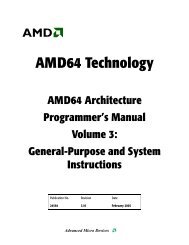Using TCP Through Sockets
Using TCP Through Sockets
Using TCP Through Sockets
Create successful ePaper yourself
Turn your PDF publications into a flip-book with our unique Google optimized e-Paper software.
fc->fd = socket (AF_INET, SOCK_STREAM, 0);<br />
if (fc->fd < 0)<br />
fatal ("socket: %s\n", strerror (errno));<br />
ncon++;<br />
make_async (fc->fd);<br />
bzero (&sin, sizeof (sin));<br />
sin.sin_family = AF_INET;<br />
sin.sin_port = htons (FINGER_PORT);<br />
sin.sin_addr = *(struct in_addr *) h->h_addr;<br />
if (connect (fc->fd, (struct sockaddr *) &sin, sizeof (sin)) < 0<br />
&& errno != EINPROGRESS) {<br />
perror (fc->host);<br />
fcon_free (fc);<br />
return;<br />
}<br />
}<br />
cb_add (fc->fd, 1, finger_senduser, fc);<br />
int<br />
main (int argc, char **argv)<br />
{<br />
int argno;<br />
}<br />
/* Writing to an unconnected socket will cause a process to receive<br />
* a SIGPIPE signal. We don’t want to die if this happens, so we<br />
* ignore SIGPIPE. */<br />
signal (SIGPIPE, SIG_IGN);<br />
/* Fire off a finger request for every argument, but don’t let the<br />
* number of outstanding connections exceed NCON_MAX. */<br />
for (argno = 1; argno < argc; argno++) {<br />
while (ncon >= NCON_MAX)<br />
cb_check ();<br />
finger (argv[argno]);<br />
}<br />
while (ncon > 0)<br />
cb_check ();<br />
exit (0);<br />
5 Scatter-gather I/O<br />
The read and write system calls move data to and from contiguous memory in a program.<br />
However, sometimes one wants to write non-contiguous data or read data into a<br />
non-contiguous buffer. Rather than incur the overhead of multiple read and write system<br />
calls or use gratuitous copies through temporary buffers, one can tell the kernel about non-<br />
25
















